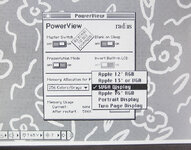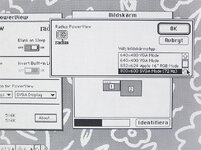PB170
Well-known member
I've had a Radius PowerView for many years. I've pretty much only used it once every two years or so, either when I've done maintenance or upgrades to my PowerBook 170 and needed to use the computer with the screen disconnected, or sometimes to play some old, nostalgic DOS games through emulation in SoftPC  I have an old CRT monitor from my parents' IBM Aptiva home computer that I've used it with. Ever since LCD monitors became mainstream I've mostly regarded it as old-fashioned, heavy and clumsy, and mostly used it because it's the only monitor with VGA support that I have – though it's recently started to feel a bit retro
I have an old CRT monitor from my parents' IBM Aptiva home computer that I've used it with. Ever since LCD monitors became mainstream I've mostly regarded it as old-fashioned, heavy and clumsy, and mostly used it because it's the only monitor with VGA support that I have – though it's recently started to feel a bit retro  Still heavy and clumsy though, and definitely not easy to move around, unlike the PowerBook.
Still heavy and clumsy though, and definitely not easy to move around, unlike the PowerBook.
Anyway, I normally find the PowerBook's crisp, internal display fully adequate for the work I do, even when working with more than one document side by side. However, I've recently found the occasional need to have two full-width spreadsheet documents arranged horizontally, which only leaves a couple of rows to work with in each window So, I thought I'd dig out the PowerView, and get a more modern and slim LCD monitor with VGA support for it. The problem is that the PowerView's support for standard resolutions stops at SVGA's 800x600, and it would be very nice to be able to use the displays at their native resolution.
So, I thought I'd dig out the PowerView, and get a more modern and slim LCD monitor with VGA support for it. The problem is that the PowerView's support for standard resolutions stops at SVGA's 800x600, and it would be very nice to be able to use the displays at their native resolution.
I assume there's a hardware limit at some point, but the driver / control panel also supports the Apple Two Page Display which is 1152x870. Since I'm only interested in using the display in black and white, in theory even a more contemporary 1280x1024 should be easy to support (800x600 at 256 colors eats up 469 kB while 1280x1024 at one bit only needs 160 kB).
The question is, has the driver ever been modified to support other resolutions, or would it be possible/easy to do? Or is the fixed set of resolutions rather a feature of the hardware itself?
The driver: https://macintoshgarden.org/apps/radius-powerview-driver-101


Anyway, I normally find the PowerBook's crisp, internal display fully adequate for the work I do, even when working with more than one document side by side. However, I've recently found the occasional need to have two full-width spreadsheet documents arranged horizontally, which only leaves a couple of rows to work with in each window
I assume there's a hardware limit at some point, but the driver / control panel also supports the Apple Two Page Display which is 1152x870. Since I'm only interested in using the display in black and white, in theory even a more contemporary 1280x1024 should be easy to support (800x600 at 256 colors eats up 469 kB while 1280x1024 at one bit only needs 160 kB).
The question is, has the driver ever been modified to support other resolutions, or would it be possible/easy to do? Or is the fixed set of resolutions rather a feature of the hardware itself?
The driver: https://macintoshgarden.org/apps/radius-powerview-driver-101


Last edited:
